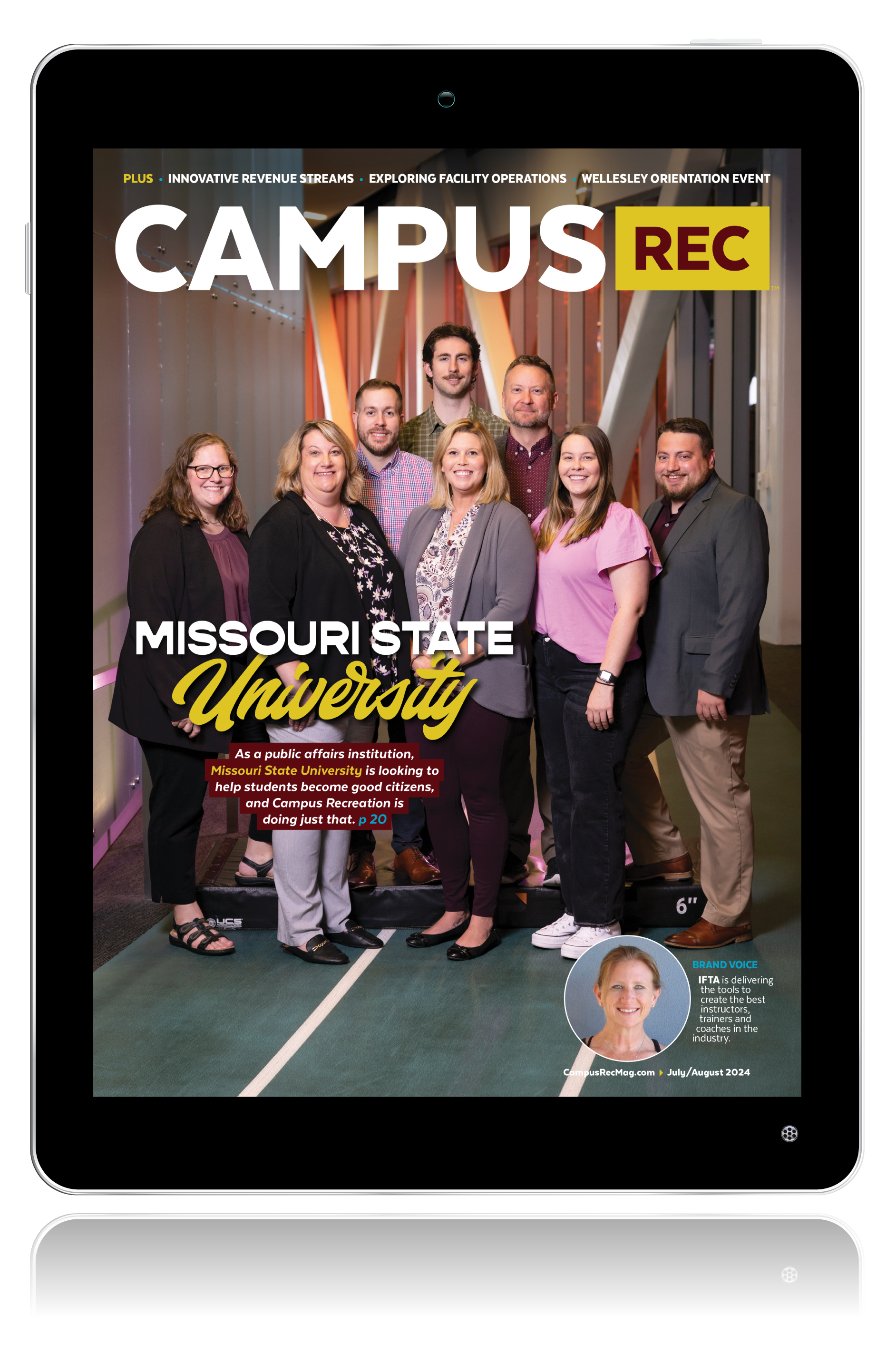Everyone knows the “safety first” rule in rec centers, but this rule is never more critical than in your aquatics center, since safety — or lack thereof — can mean life or death in certain scenarios.
To help students feel safe in and around the pools, your aquatics risk management strategy should include the right staffing choices, safer equipment and amenities, and enforcing rules. But first and foremost, it starts with cultivating a culture of risk management in your aquatics center.
For some best practices and tips on safety in aquatics, experts at the University of Missouri and Nova Southeastern University shared their thoughts.
Safety in Aquatics Culture
“We have an approach that creates a culture of risk management,” said Tec Clark, the associate director for aquatics and scuba diving at Nova Southeastern. “It’s a process for us — we’ve laid out and fleshed it out so we’re always prepared for an incident.”
This fleshed out process involves three basic questions Clark and his staff ask themselves when preparing safety protocols.
“The first step is looking at everything that could go wrong — literally everything,” said Clark. “What could possibly go wrong with the activities going on and with each person doing those activities? That’s the No. 1 question we ask and have our staff ask.”
Always assuming something will go wrong seems negative, but it’s the most effective way to identify as many potential incidents as possible. It also leads to the formulation of preemptive measures.
“The second step is asking how we can mitigate those things going wrong,” said Clark. “We do what we can to either ensure there’s no risk or at least minimize that risk. Obviously, ensuring there’s no risk at all would mean closing the pool, so we can’t completely ensure it.”
And since running an aquatics center carries inherent dangers, it’s important for your staff to know how to respond in an emergency.
“The third step is asking, ‘What happens if?’” said Clark. “We have to be able to provide the resources necessary for what we’ve identified can go wrong, because even if we do our best at mitigating risks, something can still go wrong.”
Together, these three principles form Nova Southeastern’s culture of safety in aquatics. They’re the core of how the recreation department trains its lifeguards, makes the rules, and chooses programming and amenities.

At the University of Missouri, the Tigers aquatics staff is trained similarly: preventing as many accidents as possible, but always being prepared to act in an emergency.
“We practice preventative guarding instead of reactive guarding,” said Chris Hull, the aquatics coordinator at Missouri. “Obviously, we’re here to respond if there is an issue with a patron, but we look to prevent anything from becoming an issue.”
Hull believes the most effective preventative guarding starts with education. “Teaching the staff ‘if you don’t know, go’ is important,” he said. “It may seem like something is fine, but it’s better to be immediately present than to wait two minutes before making sure someone is OK.”
Hull and his staff also pay close attention to the students using the pools to make sure someone isn’t entering an area they shouldn’t go into or trying something dangerous.
“We look at swimmers’ abilities — you can tell pretty quickly if something is going to become an issue,” said Hull. “For example, we have ‘no diving’ areas and if we see somebody looking at the water and taking three steps back, that’s a pretty good indicator they’re getting ready to dive.”
And diving into the shallow end isn’t the only stupid thing a student might try. Anything from running on a wet pool deck to climbing up on decorative rock islands can be a hazardous activity.
“Shallow water blackouts and people doing hypoxic training — holding their breath for a long amount of time — are huge risks, so we don’t allow people to do that,” said Hull. “If we see someone holding their breath, trying to build up, we stop it before it becomes an actual situation.”
There’s also a certain initiative each individual staff member should take to ensure the highest level of safety — and the leadership team sets that example.
“Personally, as a manager, I’m constantly walking around the facility and looking for anything that could cause issues and making sure we’re getting them taken care of,” said Hull.
Staff Education
Your aquatics risk management hinges on your staff’s attention to detail and ability to respond correctly to emergencies. Nova Southeastern trains its lifeguards very carefully, but also seeks a certain type of employee from the beginning to ensure safety in aquatics.
“We first want someone who understands the risks and their role in managing risk,” said Clark. “That requires a mature individual. We’re looking for somebody who’s going to understand how we approach risk and aquatic supervision.”
After the right person is found, the training begins, and its purpose isn’t just to educate staff members on protocols. The training is designed to simulate live emergencies.
“Between a combination of staff meetings and in-service trainings, we present a very real and intense exercise for risk management,” said Clark. “We don’t want them to experience any surprises when the real thing happens, so we make the training as realistic as possible.”
To make the simulated emergencies seem real, Clark and his leadership team hold nothing back. While trainees are dragging mannequins out of the pool and giving mouth-to-mouth resuscitation, loud alarms are blaring and sometimes the mannequins will regurgitate an artificial “sputum” like a human produces in a near-fatal drowning.
“We need to have our lifeguards understand there will be bad stuff coming out of the mouth and nose of a swimming accident victim,” said Clark. “What we do is similar to the old volcano experiments you used to do as a kid, which produces a very similar type of froth and foam that comes out of the mouth of the mannequin.”
According to Clark, all these drastic measures gives trainees a realistic simulation to practice remaining calm and managing an adrenaline rush in a high-pressure emergency.
“We’re known for putting wetsuits on our mannequins,” said Clark. “That requires our staff to get the individual out of the wetsuit if they want to use the AED. We use forceps to cut the wetsuit in a T-pattern to butterfly it open, so the majority of the wetsuit stays on the person, but we’ve cut it to expose the chest.”
Missouri also understands the importance of having well-trained lifeguards. “It’s extremely important for them to be well-educated because they’re the front-line, the ones seeing what’s going on,” said Hull. “We have lots of lifeguards — I’m just one person, they are many.”
According to Hull, the best lifeguards need to already be trained in some capacity and physically capable of carrying out their duties before working for the aquatics department.
“Every place is different, so I want to see what that individual’s actual abilities are before they’re ever hired,” said Hull. “I need to know, going into their employment, they’re trained and physically capable of performing the tasks necessary in case of emergencies.”
After going through a skills assessment and being hired, the guards are trained. They learn how to respond to an emergency and communicate the importance of aquatics risk management to users.
Safety in Aquatics User Education
“We’re huge believers in needing to educate on the ‘why,’” said Clark. “We have these huge boards of rules for the pool that are plastered everywhere — many people don’t read them, and even if they do, a rule is just a rule.”
It’s imperative to give the practical reason for the rule to students. “There’s no explanation for each rule, so we educate based on the rule,” said Clark. “Whenever a rule is questioned or brought up, we address it.”
Part of that education effort is understanding the resistance you’ll get from students. According to Hull, there will always be students who believe nothing will happen to them, which makes education on aquatics risk management even more important at your rec center.
“Students aren’t going to like every rule, but we have to educate them on the possible accidents that could occur,” explained Hull. “We have these rules in place because we want to prevent accidents from happening.”
Every aquatics center has a sign by the door with its rules, but you can always go a step further. Preventing accidents will provide a safer and more positive experience for students, so don’t hesitate to take creative measures to communicate the rules.
“There are many different reasons for various rules, so we have individuals dedicated to teaching others,” said Clark. “It’s part of the student affairs model in which we want to equip students for success in life.”










